Union & its Territory (Article 1-4) | General Awareness - Bank Exams PDF Download
Part I: The Union & Its Territory (Article 1 - 4)
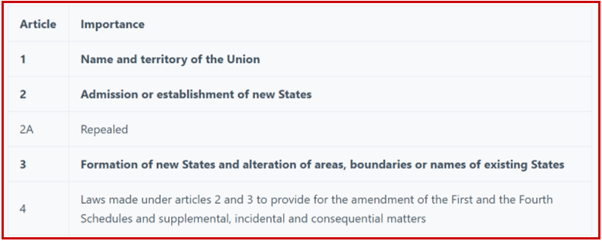
Article 1
1. India, that is Bharat, shall be the Union of States.
2. The States and UTs thereof shall be as specified in the first schedule.
3. Territories of states
- UTs as specified in the first schedule
- Such other territories as may be acquired
Article 1 states India or Bharat as ‘Union of states’ rather than ‘Federation of States’
The territory of India consists of
- The territories of the states
- The Union Territories
- Any territories that may be acquired by India
As on today, there are 28 states and 8 Union territories in the country.
The 8 Union territories are:
- Delhi
- The Andaman and Nicobar Islands
- Lakshadweep
- Dadra and Nagar Haveli & Daman and Diu
- Ladakh
- Pondicherry
- Chandigarh
- Jammu and Kashmir
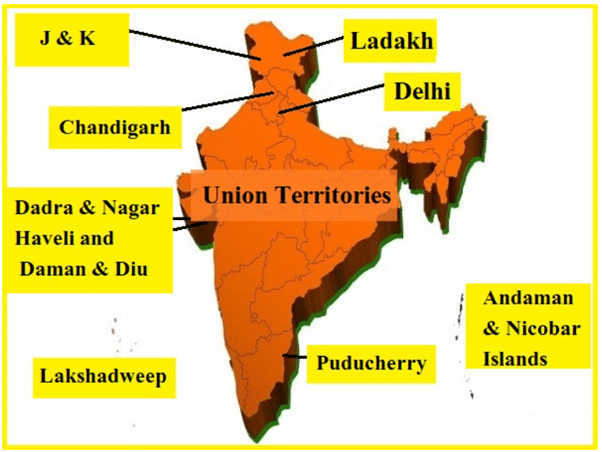
- “Union of India” includes only states whereas “Territory of India” covers states and union territories.
- States share power with the Central government and Union Territories are administered by Central Government.
- The names of the states and the Union territories and the territories covered by each of them have been described in the first schedule of the Constitution.
- India can acquire foreign territory through modes recognised by International law: cession, occupation, conquest or subjugation.
- The other countries possessions can be added to India through Constitutional amendments.
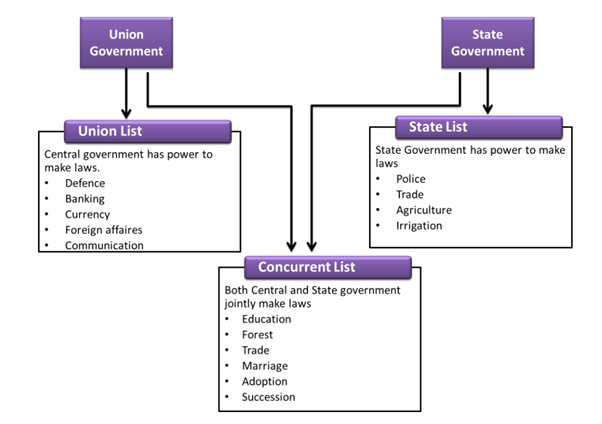
Article 2
Parliament may by law admit new states into the union of India or establish new states on such terms and conditions as it thinks fit.
Article 2 of the Indian Constitution provides two powers to the Parliament:
- The power to admit the new states into the Union of India And
- The power to establish new states.
- In the year 1974, the Sikkim Assembly passed the Government of Sikkim Act, 1974.
- This act empowered the Government of Sikkim to seek participation and representation of the people of Sikkim in the Indian political institutions for the speedy development of Sikkim.
- The resolution also meant for the representation of the people of Sikkim in the Indian Parliamentary system.
- In the year 1974, the 35th Constitution amendment act was passed by the Parliament to give effect to the resolution.
- The main provisions of the 35th amendment act are Sikkim will be an ‘associate state’ of India.
- There was criticism regarding the 35th amendment of the Constitution since the original Constitution did not mention the ‘associated state’.
- The Parliament passed the 36th amendment act. Sikkim has been admitted into the Union of India as a state.
- The 36th amendment act came into effect on April 26, 1975.
- Article 371F inserted to make some special provisions relating to the admission of Sikkim.
Article 3
The parliament may by law is empowered to:
- Form a new state By separation of territory from ant state OR by uniting 2 or more states or parts of states OR By uniting any territory to a part of any state.
- Increase the area of any state
- Diminish the area of any state
- Alter the boundaries of any state
- Alter the name of any state
The Constitution empowered the Parliament to reorganise the boundaries of the states by a simple majority. It means the Constitution authorises the Parliament to make new states or alter the areas of existing states.
Article 3 lays down two conditions in the formation of new states.
1. The bill can be introduced in Parliament only with the prior recommendation of the President.
2. The President shall before giving a recommendation refer the bill to the legislature of the state which is going to be affected by the changes proposed in the bill.
- The state legislature must express its view in the time specified by the President.
- The President is not bound by the view of the state legislature and may accept or reject them.
- It is not necessary to make a fresh reference to the state legislature every time an amendment to the bill is moved and accepted in Parliament.
- In the case of Union territory, no reference need be made to the concerned legislature to ascertain its views and the Parliament can itself take any action as it deems fit.
Article 4
- Any law referred to Article 2 or 3 shall contain such provisions for the amendment of the first schedule and fourth schedule as may be necessary to give effect to the provisions of the law and may also contain such supplemented, incidental and consequential provisions.
- No such law as aforesaid shall be deemed to be an amendment of this Constitution for the purpose of Article 368.
It means these can be passed without resorting to any special procedure. This can be done by a simple majority of the parliament like any other piece of ordinary legislation.
The names of the states can be changed through the provision of Article 3
Following is the list of name changes that have happened over time:
- In the year 1950 the states United Provinces was renamed Uttar Pradesh.
- In the year 1969, Madras was renamed “Tamil Nadu”. This was done through Madras State (Alternation of the name) Act, 1968 with effect from January 14, 1969.
- In the year 1973, Mysore was renamed ‘Karnataka’. This was done through Mysore State (Alternation name) Act, 1973.
- In the year 1973 Laccadive, Minicoy and Amindivi Islands renamed ‘Lakshadweep’.
- In the year 1992, the Union Territory of Delhi was re-designated as the ‘National Capital Territory of Delhi’. This was done through the 69th amendment act, 1991 with effect from February 1, 1992.
- In 2006 Uttaranchal was renamed Uttarakhand.
- In 2006 Pondicherry was renamed Puducherry.
- In 2011 Orissa was renamed Odisha.
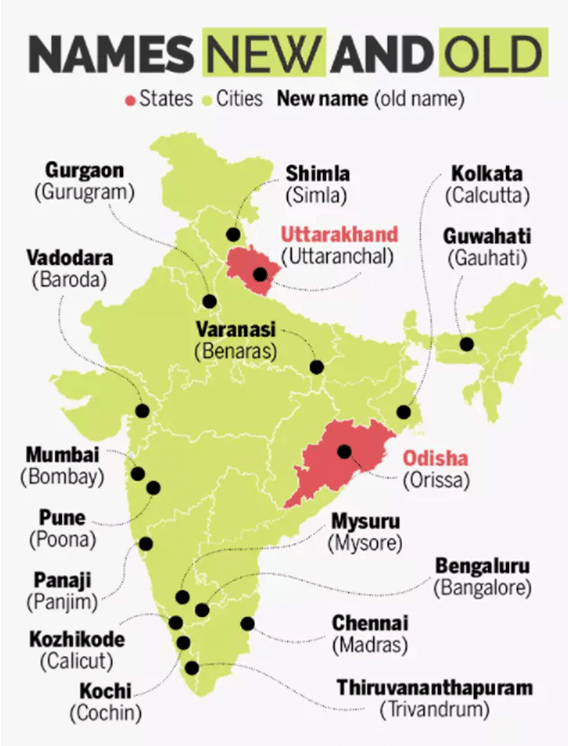
Other Important Points
- The name of the country was discussed in the Constituent Assembly. While “Bharat” was the ancient name and India was the modern name. As a member of the United Nations also the name of the country was India and all the international agreements were entered in that name. As a compromise ‘India’ that is ‘Bharat’ was accepted.
- No state in India could secede from the Union. The Parliament’s power to diminish the area of any state does not cover the cession of Indian Territory to a foreign state.
- In the Berubari (West Bengal) case of 1960 on a presidential reference, the Supreme Court expressed the opinion that no cession of territory could be made without a constitutional amendment under Article 368. To give effect to an agreement with Pakistan for the transfer of part of the Berubari territory, the 9th constitutional amendment took place in the year 1960.
- In the year 1969, the Supreme Court ruled that settlement of a boundary dispute between India and another country does not require a constitutional amendment. It can be done by an executive action since it does not involve the cession of Indian Territory to a foreign country.
- The 100th Constitutional Amendment Act of 2015 was enacted for acquiring certain territories by India and transferring some other territories to Bangladesh. India transferred 3 enclaves whereas Bangladesh transferred 51 enclaves to India.
- India is an indestructible Union of destructible states. (The Union Government can destroy the states. In the USA, the Federal government cannot create states or modify existing states without their consent.). The country is described as the ‘Union’ although the Constitution is federal in structure. At the time of independence, India comprised two categories of political units, namely the British provinces and princely states. The Indian independence Act, 1947 gave 3 options to the princely states, either to join India or Pakistan or remain independent.
- Out of 552 princely states, 549 integrated with India by the efforts of Sardar Vallabhbhai Patel.
- The Hyderabad state was integrated through Police action.
- Junagarh was integrated through the referendum.
- Kashmir was integrated through Instrument of Accession.
The Indian Constitution of 1950 contained 29 states. The 29 states were classified into 4 parts.
- Part A contained 9 erstwhile governor’s provinces of British India.
- Part B contained 9 erstwhile princely states with legislatures.
- Part C contained 10 states. (Erstwhile Chief Commissioner’s provinces of British India and some of the erstwhile princely states). These states were centrally administered.
- In Part D the Andaman and Nicobar Islands were kept as solitary (lonely).
The Territory of India in 1950
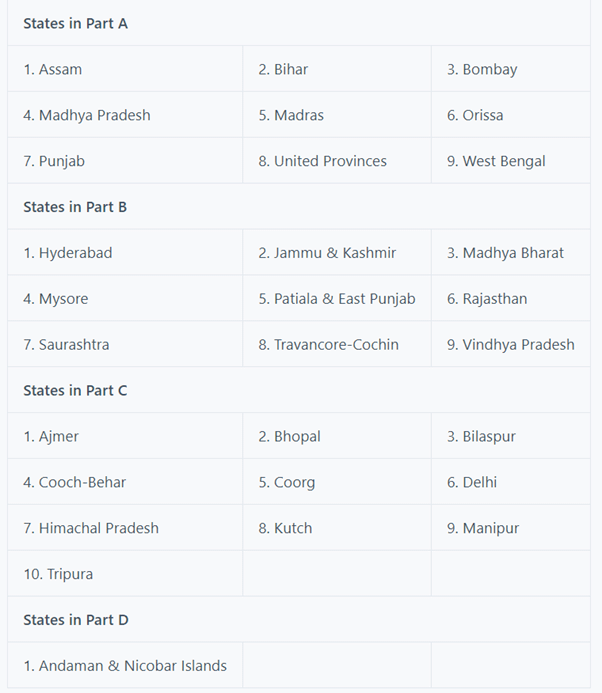
The Fazal Ali commission suggested getting away from the system of the 4-part state. By the States Reorganisation Act of 1956, and the 7th Constitutional Amendment Act of same year, Part A and Part B were merged, and Part C was abolished completely. As a result, 14 states and 6 union territories were created on 1st November 1956.
States & Union Territories created after 1956:
- Maharashtra & Gujarat were carved out of Bombay state based on language. Maharashtra for Marathi-speaking people and Gujarat for Gujarati speaking people.
- Dadra and Nagar Haveli: Through the 10th amendment of the Constitution in the year 1962 the Portuguese enclaves (possessions) of Dadra and Nagar Haveli was constituted into Union territory.
- Similarly Goa, Daman and Diu were added as a Union territory by the 12th Constitutional amendment in the year 1962.
- The Pondicherry together with Karaikal, Mahe and Yanam was ceded to India by the French government in the year 1954. In the year 1962 through the 14th Constitutional amendment Pondicherry together with Karaikal, Mahe and Yanam, the French possessions were added as a Union territory.
- Nagaland was carved out of Assam by taking Naga Hills & Tuensang area. It was the 16th State formed in 1963.
- Haryana, Chandigarh and Himachal Pradesh: Punjab was bifurcated to create Haryana and the Union Territory Chandigarh in 1966. Haryana was the 17th state. in 1971, Himachal Pradesh was elevated as the 18th state of India.
- Manipur, Tripura, and Meghalaya: In 1972, the two union territories Manipur and Tripura were elevated to state. The sub-state Meghalaya was also made into a state. This gave birth to 2 new union territories – Mizoram and Arunachal Pradesh (originally known as North-East Frontier Agency – NEFA) which were from territories of Assam. India now had 21 states.
- Sikkim: Until 1947, Sikkim was a princely state ruled by Chogyal. Sikkim was made a full-fledged state by the 36th constitutional amendment in 1975. This amendment changed the First and Fourth Schedules of the Constitution and add new Article 371-F.
- Mizoram, Arunachal Pradesh and Goa were created in 1987. Goa was created by separating itself from the Union Territory of Goa, Daman and Diu.
- Chhattisgarh, Uttarakhand and Jharkhand were created in 2000. Chhattisgarh was carved from Madhya Pradesh, Uttarakhand from Uttar Pradesh, and Jharkhand from Bihar.
- Telangana was created in 2014 after a long struggle.
In January 2012, the DMK (Dravida Munnetra Kazhagam) demanded that the taluks of Devikulam and Peermedu, now in Kerala and forming parts of the catchment of the Periyar river be merged with Tamil Nadu.
This demand was first made by DMK way back in 1956 and 1957. The decision for the creation of a new state “Telangana’ has been announced by the Congress Working Committee on July 30, 2013. On December 4, 2013, the GoM (Group of Ministers) submitted its final recommendations to the Cabinet.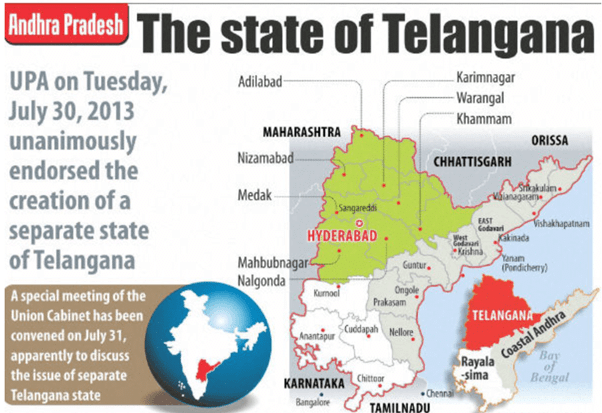
At the same time, the dormant demands from various states have been surfaced. Followings are the demands for separate states:
- Paschimanchal, Harit Pradesh, Bundelkhand, Awadh Pradesh and Purvanchal in the state of Uttar Pradesh.
- Vidarbha in Maharashtra.
- Gorkhaland in West Bengal.
- Bodoland and Karbi Anglong in Assam.
|
366 videos|701 docs|149 tests
|
FAQs on Union & its Territory (Article 1-4) - General Awareness - Bank Exams
| 1. What is the meaning of the term "Union" in Article 1 of the Indian Constitution? |  |
| 2. What does Article 2 of the Indian Constitution state about the admission or establishment of new states? |  |
| 3. Can the Parliament alter the boundaries of existing states in India? |  |
| 4. What does Article 4 of the Indian Constitution state regarding the laws made for the establishment or formation of new states? |  |
| 5. Are there any limitations on the power of the Parliament to create new states in India? |  |

















